The therapeutic use of water gained particular popularity in Europe in the late 19th century, with the development of health spas in areas of natural springs such as Baden-Baden and Bad Ragaz, and shortly thereafter in the United States in similar areas of natural hot springs (Arkansas, California, New York, and Virginia). Although hydrotherapy has been shown to have wide-ranging therapeutic effects and benefits, its use today continues to be limited, largely due to the expenses associated with establishing and maintaining a safe hydrotherapy environment.
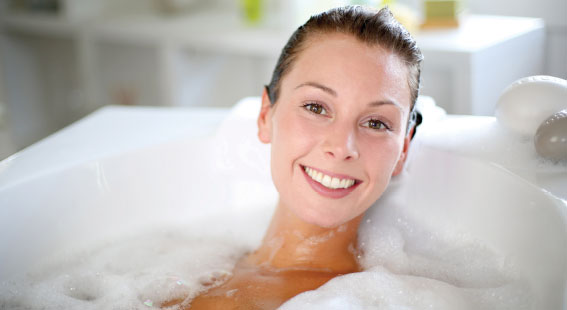 Properties of Water
Properties of Water
Water has a number of unique physical properties that include a relatively high specific heat and thermal conductivity and the ability to provide buoyancy, resistance, and hydrostatic pressure to the body.
Specific Heat and Thermal Conductivity
Water can transfer heat by conduction and convection and can therefore be used as a superficial heating or cooling agent. It is particularly effective for this application because it has a high specific heat and thermal conductivity. During hydrotherapy, heat is transferred from warm water to the body by placing the limb in a container filled with warm water. Heat may also be transferred from the body to cooler water by immersing a limb in a container filled with cold water.
Water Bath Therapies
Baths are given as: arm bath, foot bath, or full bath. These baths may be taken cold (32 to 65 degrees Fahrenheit), cool (66 to 71 degrees Fahrenheit), lukewarm (72 to 82 degrees Fahrenheit), intermediate (83 to 95 degrees Fahrenheit), warm (96 to 100 degrees Fahrenheit), or hot (101 to 105 degrees Fahrenheit). Warm baths may be taken with herbal essential bath oil additives such as balm mint, chamomile, eucalyptus, lavender, thyme, and pine needle.
Neutral Bath
The neutral bath, sometimes called the continuous bath, is a non-thermic hydrotherapy of great value. It is a full-body immersion in water, approximately 92 to 97 degrees Fahrenheit.
Begin by filling a full-size bathtub with water of neutral temperature. Make the client comfortable with a pillow or rolled towel for their head and adjust the water to temperature neutral to the client. Clients should feel somewhere between comfortably warm and neither warm nor cold; this is a better guide than the thermometer, although the actual temperature should be monitored, in any case. Cover any exposed parts with towels, or cover whole bathtub with sheet. The lighting in the treatment room should be dim. Add water to the bath, as necessary, to maintain neutral temperature. The bath should be between 15 minutes to one hour for insomnia. Cool the water a few degrees at the end of the treatment and assist the client out of the bathtub. The client should dry quickly but gently without friction, which would be too stimulating for a calmative treatment. The client should rest for half an hour.
This treatment works well for clients who are experiencing insomnia, nervous exhaustion, anxiety, and depression. Withhold this treatment from clients who are experiencing fever, acute hypertension, diabetes, chronic pain, toxemia or pregnancy, peripheral edema, eczema, or other skin conditions aggravated by water.
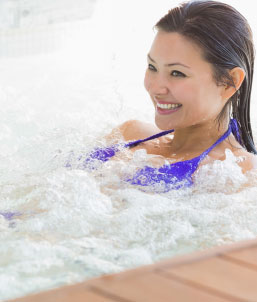 Hot Bath
Hot Bath
With the hot bath treatment, the whole body is immersed in water except for the client’s head. Excluding the head, the body cannot control its temperature by sweating, but the body is more heated since there is direct contact with the water and water has the property to carry heat and conducts it very well. To begin, fill the bathtub two-thirds full of hot water, approximately 104 degrees Fahrenheit and assist the client into the bathtub. Cover any exposed body parts with a towel or cover the bathtub with a sheet or light blanket. Keep the head cool with a cold compress. Check the client’s pulse regularly and do not let it exceed 80 beats per minute.
After assisting the client out of the bathtub, follow with an alcohol rub or a cool sponge bath. The client should dry thoroughly and be kept warm. They should rest for one hour after the treatment.
This treatment is great for clients who are experiencing poor circulation, pain, muscle stiffness, general fatigue, and congestion of internal organs. Withhold this treatment from clients who are experiencing heart disease, diabetes, diseases of malignant origin, vascular disorders, or high blood pressure. Also understand that frail clients will not tolerate hot baths well. If dizziness or faintness develops, stop the treatment at once. It is also wise to never leave the client alone.
Whirlpool Bath
A whirlpool bath combines a thermal stimulus of the water with further mechanical stimuli. One way this occurs is with the aid of a rotating propeller, which moves the water. In addition, a jet of warm air is injected into the water through a small nozzle. Depending on the size, the whirlpool bath can be used either as a partial bath for the lower legs or arms, or as a full bath for the entire body. The whirlpool bath should not be compared to the underwater massage, as the mechanical component is weaker. Whirlpool baths are used primarily after injuries and for clients with rheumatic disabilities, including rheumatic muscle and joint disorders, as well as for relaxing after practice and competition.
One of the outstanding therapeutic uses of the whirlpool bath is to relieve muscle soreness and fatigue. This is the reason many athletes and dancers purchase portable whirlpools for their bath or go swimming in a pool with such whirlpool action.
Whirlpool baths are helpful in anti-pain therapy. Begin the whirlpool bath at a neutral temperature and raise to the tolerance of the client. A whirlpool bath can vary from 15 to 45 minutes in duration, depending on the purpose for which it is being used. If the bath will be followed with a massage, wrap the client’s entire body to keep it completely warm.
Prepare the client for a massage by first providing a stimulating and relaxing whirlpool bath. Clients who are sensitive to very hot water should not use a whirlpool bath. This includes all clients with diabetes, varicose veins, advanced arteriosclerosis, or any advanced vascular limb problem.
Whirlpool therapy can help with circulation problems and is a well-known aid in relieving chronic pain and the phantom pain that occurs after amputations. Whirlpool therapy will help relieve muscle soreness and body fatigue, especially after vigorous athletic activity. It will also help heal skin sores and infected wounds, reduce the swelling of chronic edema (tissue swelling), help reduce the pain of minor frostbite, ease scar tissue from burns, and help with weak and painful feet.
Arm Bath – Alternative Temperature
This treatment will increase blood circulation for the client. Have the client seated comfortably for this treatment. Fill one arm bath bucket with warm water, approximately 96 to 100 degrees Fahrenheit. Fill another arm bath bucket with cold water, approximately 65 degrees Fahrenheit. Dip both arms in the warm bath bucket, up to the middle of the upper arm. Repeat the procedure in the cold water. The duration of this treatment should be as follows: five minutes warm water, 10 seconds cold water, five minutes warm water, 10 seconds cold water. Afterwards, wipe off the client’s arms with your hands. Do not towel dry. They should exercise their arms until warm. One hour of rest is recommended following this treatment.
Herbal bath additives can be included only in the warm water. Use herbs such as balm mint, chamomile, lavender, meadow flower, pine needle, or rosemary.
This treatment is great for clients who are experiencing blood circulation problems, high blood pressure, or bronchitis. Withhold this treatment from clients who are experiencing angina pectoris and heart ailments.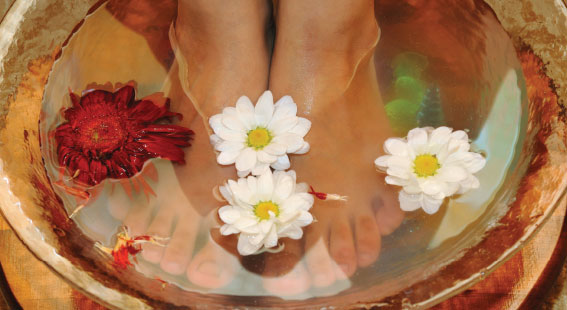
Foot Bath – Alternative Temperature
This treatment will increase the body’s heat regulatory system, improve blood circulation, and stabilize the nervous system. To begin, fill one foot bath bucket with warm water, approximately 97 to 100 degrees Fahrenheit, and a second one with cold water (as cold as possible). Put the client’s feet in the warm water. Repeat the procedure in the cold water. The duration of this treatment should be as follows: five minutes warm water, 10 to 15 seconds cold water, five minutes warm water, and 10 to 15 seconds cold water. Wipe the client’s feet with your hands. Do not towel dry. They should exercise their legs until warm. One hour of rest is recommended following this treatment.
Herbal bath additives can be included in only the warm water. Use herbs such as balm mint, chamomile, lavender, alpine meadow flower, pine needle, or rosemary.
This treatment is great for clients who are experiencing chronic cold feet, low blood pressure, or insomnia. Withhold this treatment from clients who are experiencing varicose veins.
Mineral, Herbal and Essential Oil Baths
There are many herb and pharmaceutical substances that can be added to baths to produce special effects. Water by itself has a remarkable, almost magic ability to alter the body’s state. Depending on the specific need, water can decrease or increase muscle tone, reduce pain, or generate energy. The addition of certain herbal and pharmaceutical substances to the water is a twin present to the body. Some herbs soothe while others sedate or stimulate or soften the skin. Most important is the ability of some substances to hasten perspiration and stimulate the release of stored toxins from within the body. This ability can help overcome many acute attacks and improve a chronic condition.
Fango-Mud Salicyl Powder Bath
This bath is the ultimate and favorite fragrant mud bath in European spas. The analgesic properties of the volcanic ash powder extract (fango-mud) mixed with salicyl and pine needle essential oils help to alleviate aches and pains of rheumatism in muscles and joints. The bath stimulates circulation, replaces minerals, and gently exfoliates the skin. It is recommended for use three times per week for at least four weeks in order to experience relief from sciatica, neuritis, degenerative non-inflammatory joint arthrosis, and lumbago.
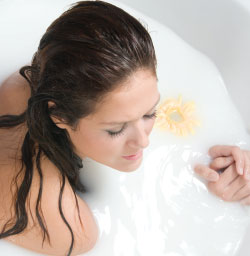
Milk-Whey Powder Bath
What is whey? Whey is composed of all milks. Liquid cow’s milk has about 6.25 percent protein, and of that protein, 80 percent is whey. Traditionally, the term whey protein describes those milk proteins that remain after the cheese making process uses up the casein molecules. In bygone days, whey was fed to young livestock on the farm for nutritional values.
Whey is a complete protein containing all essential and non-essential amino acids found in nature. History reveals ancient wisdom of whey’s health and beauty powers. Hippocrates, the Greek, and then the Italian promoted the health and beauty benefits of whey. It has become Europe’s foremost skin care bath product.
The milk whey bath is particularly useful for aging and dry skin, neurodermatitis, psoriasis, acne, eczema, baby rash, fungus and many other skin ailments. The milk whey bath has a true moisturizing effect and is naturally cleansing. Bathing in milk whey helps sunburned skin and returns its smoothness. It is recommended not to use soap or shower after the bath, but to envelope into a robe and rest, allowing the protein to bond with the skin.
Mud Natrium Powder Bath
The fango-mud natrium powder bath used in spas worldwide is a mineral-rich, volcanic ash extract. This ancient beauty ritual is effective for removing impurities and smoothing the texture of the skin so it can readily absorb moisture and minerals.
Fango treatments relax tired muscles, detoxify, and revitalize the body. Fango-mud natrium powder is biologically pure and bacteria free, unscented, and fully dissolves in bath water. It will not stain the bathtub or the body.
Seaweed Powder Bath
Seaweed baths stimulate blood circulation, help eliminate toxins, aid in slimming and toning the skin, and give the body all the mineral salts and trace elements that it needs to maintain the correct balance of cells.
The deep frozen and dried seaweed product (lyophilisation) ensures the conservation of the product’s natural qualities in a way no other method can. It conserves mineral salts, vitamins, enzymes, and aroma.
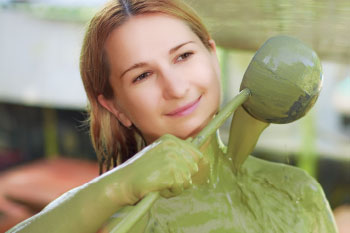 Herbal Essential Oil Baths
Herbal Essential Oil Baths
Herbal essential oil baths like lavender, chamomile, pine needle, thyme, balm mint, valerian, eucalyptus, and rosemary are highly concentrated and contain vitamins, hormones, antibiotic, and antiseptics. In a warm bath, the oils are absorbed through the skin, inducing deep relaxation that reduces stress, tension, and muscle aches.
Bicarbonated Bath
A bicarbonated mineral pearl bath is great for stress release and minor pain relief that happens when this effervescent salt is added to 86 to 98 degrees Fahrenheitbathwater.
Bicarbonated baths alleviate mild forms of dermatological high blood pressure, vegotonic and respiratory conditions, muscle fatigue, and efficiently detoxify the skin.
Oxygen Bath
The oxygen-activated bath salt develops smooth pearl bubbles across the skin and soothes the inside releasing tension, increasing physical vitality, regenerating the nervous and metabolic system, and improving blood circulation in arms and legs.
There are many hydrotherapy treatments that have a wide range of therapeutic benefits. Bathing in water is a natural way of healing. With all of the various types of bath therapies available, there is a way to treat every client’s needs.
 Reinhard R. Bergel, M.D. has owned and operated a health spa and physical rehabilitation center in San Francisco, Calif. He is renowned for his holistic and creative abilities in physical rehabilitation, health resort, and spa therapy services. Dr. Bergel founded the International S.p.a.Therapy Training Institute in 1986. In addition to providing comprehensive education and training to individuals who desire to focus their careers in the area of spa therapy, he has established H-e-a-t. Inc (Health-equipment-accessories-training. Inc), a consultation service for spa therapy development, facility staff training, and administration. He also co-published the Spa Encyclopedia.
Reinhard R. Bergel, M.D. has owned and operated a health spa and physical rehabilitation center in San Francisco, Calif. He is renowned for his holistic and creative abilities in physical rehabilitation, health resort, and spa therapy services. Dr. Bergel founded the International S.p.a.Therapy Training Institute in 1986. In addition to providing comprehensive education and training to individuals who desire to focus their careers in the area of spa therapy, he has established H-e-a-t. Inc (Health-equipment-accessories-training. Inc), a consultation service for spa therapy development, facility staff training, and administration. He also co-published the Spa Encyclopedia.
Want to read more?
Subscribe to one of our monthly plans to continue reading this article.